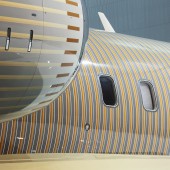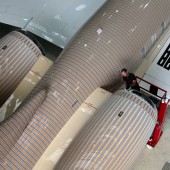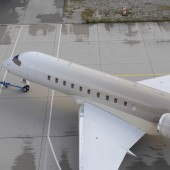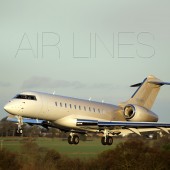
| THE AWARD |
| CATEGORIES |
| REGISTRATION |
| SUBMIT YOUR WORK |
| ENTRY INSTRUCTIONS |
| TERMS & CONDITIONS |
| PUBLICATIONS |
| DATES & FEES |
| METHODOLOGY |
| CONTACT |
| WINNERS |
| PRESS ROOM |
| GET INVOLVED |
| DESIGN PRIZE |
| DESIGN STORE |
| THE AWARD | JURY | CATEGORIES | REGISTRATION | PRESS | WINNERS | PUBLICATIONS | ENTRY INSTRUCTIONS |
Air Lines Aircraft Livery Design by Didier Wolff |
Home > Winners > Design #32864 >Interview |
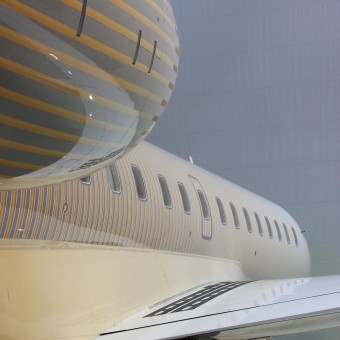 |
|
FS: What is the main principle, idea and inspiration behind your design?
DW: To create the most complexe design ever painted onto an aircraft.
FS: What has been your main focus in designing this work? Especially what did you want to achieve?
DW: Keep the client's desire within the project along with making it a challenge to achieve.
FS: What are your future plans for this award winning design?
DW: Air to Air video and photo shoot.
FS: How long did it take you to design this particular concept?
DW: A little over 3 months
FS: Why did you design this particular concept? Was this design commissioned or did you decide to pursuit an inspiration?
DW: This design was commissioned by our client, based on a ceramic tile which only a certain rhythm and colors remain in the final realization.
FS: Is your design being produced or used by another company, or do you plan to sell or lease the production rights or do you intent to produce your work yourself?
DW: No, each of my creations are unique, original and for 1 aircraft only.
FS: Where there any other designs and/or designers that helped the influence the design of your work?
DW: None
FS: Who is the target customer for his design?
DW: Private jet owners
FS: What sets this design apart from other similar or resembling concepts?
DW: The complexity of its application onto the aircraft and the amount of details.
FS: Which design tools did you use when you were working on this project?
DW: The usual computer graphic softwares (Maya, Mental Ray, Photoshop & Illustrator)
FS: What is the most unique aspect of your design?
DW: Triple overlaying of a complete fading effect.
FS: Who did you collaborate with for this design? Did you work with people with technical / specialized skills?
DW: Once the design was created and validated, we have worked with the most skilled painters for each of the very technical painting challenges. Most particularly with Walter Maurer & Martin Dipell (Walter Maurer was also an artistic partner of Andy Warhol, Roy Lichtenstein and Frank Stella.)
FS: What is the role of technology in this particular design?
DW: Essential, as its painting onto the aircraft has required a mixed of ancient and very modern tools to overcome each technical challenges that the design raised and most of all a lot of creativity.
FS: What are some of the challenges you faced during the design/realization of your concept?
DW: Main Challenges were encountered in production phase, going from the 3D Design Livery Project to the scale 1 aircraft. Quadruple stripping from the front door to the last window adjusted with Lasers, masking, de-masking and re-masking for the application of the 5 colors. From the last window to the back cone, each stripe had to face the cylindric imperfections, adjusted one by one, cm by cm and correcting each imperfection to render the natural feeling of perfect alignment. Critical zones as the engine pylons and the last meter of the back cone took an entire team and days of adjustments to meet validation. The engine nacelles shape was the hardest technical challenge in order to render the space between the lines properly. All of these technical issues had to be overcome within a strict dead line of 6 weeks and timelines of 72 hours maximum between each paint applications in order to comply with the products constraints. The fading effect on the 4 main colors, one after the other, had to be performed with the same precision from both sides of the aircraft simultaneously from the two expert teams, at the same rhythm, with the same technical hand movement. Finally, the mandatory security technical markings on the aircraft had to be deformed, resized, adapted in order to comply with the aeronautical regulation and the aesthetic aspect of the design.
FS: How did you decide to submit your design to an international design competition?
DW: This design is so unique and is the first of its kind in the aeronautical industry in terms of complexity that it is a natural desire to have it recognized by the artistic community.
FS: What did you learn or how did you improve yourself during the designing of this work?
DW: Never compromise with your creation.
FS: Any other things you would like to cover that have not been covered in these questions?
DW: It required a lot of trust and open mind from the aircraft owner to make this design possible, we are extremely thankful for this.
FS: Thank you for providing us with this opportunity to interview you.
A' Design Award and Competitions grants rights to press members and bloggers to use parts of this interview. This interview is provided as it is; DesignPRWire and A' Design Award and Competitions cannot be held responsible for the answers given by participating designers.
| SOCIAL |
| + Add to Likes / Favorites | Send to My Email | Comment | View Press-Release |

